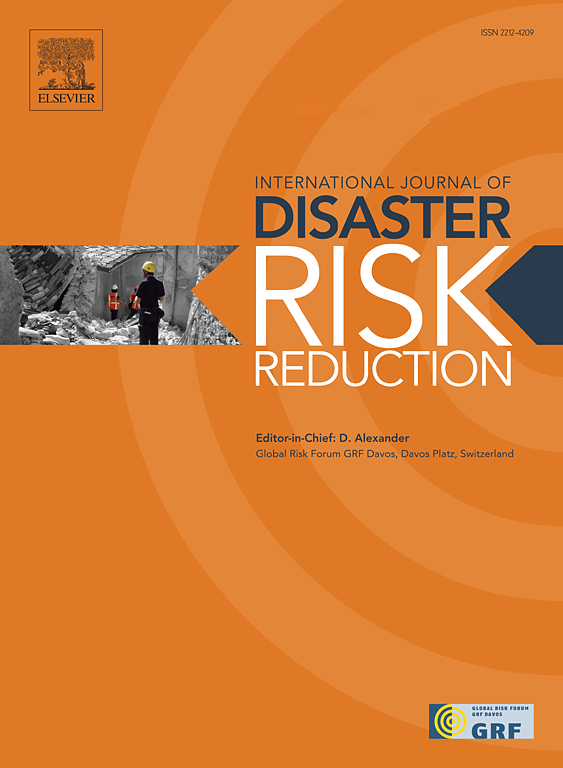我们准备好下一个了吗?评估印度洋海啸后20年的社区疏散准备
IF 4.2
1区 地球科学
Q1 GEOSCIENCES, MULTIDISCIPLINARY
International journal of disaster risk reduction
Pub Date : 2025-04-15
DOI:10.1016/j.ijdrr.2025.105430
引用次数: 0
摘要
在亚齐省(印度尼西亚),班达亚齐市及其周边地区由于地处灾害易发区,面临着持续和严重的海啸威胁。2004年12月26日,该地区被一场灾难性的海啸摧毁。二十年后,虽然人们对海啸风险的认识有所提高,但社区对疏散的准备工作仍然不一致。本研究旨在评估社区疏散策略,并确定海啸易发地区疏散准备的关键决定因素,重点关注教育、年龄、疏散培训、当地智慧和楼层类型等社会经济指标。该研究采用横断面调查设计,通过问卷调查和焦点小组讨论(FGD)收集了287名受访者的数据,其中25名参与者代表政府、非政府组织、社区领袖和学术界,并在灾害易发地区进行了实地观察。使用有序逻辑回归对数据进行分析,以确定准备的关键预测因素。这些发现证实了先前的研究,强调了备灾的复杂性,以及基于社区的倡议的关键作用。这项研究强调了公平获取资源、包容性培训计划和将地方智慧纳入正式备灾框架的必要性,以增强社区的复原力。最后,该研究强调了量身定制的准备战略的重要性,包括虚拟疏散工具,以提高海啸疏散的有效性和加强脆弱地区的社区准备。本文章由计算机程序翻译,如有差异,请以英文原文为准。
Are we prepared for the next one? Evaluating community evacuation preparedness 20 years after the Indian Ocean tsunami
In Aceh province (Indonesia), the city of Banda Aceh and the surrounding areas face a persistent and significant tsunami threat due to their location in a disaster-prone zone. On December 26, 2004, the region was devastated by a catastrophic tsunami. Twenty years later, while awareness of tsunami risks has grown, community preparedness for evacuation remains inconsistent. This study aims to assess community evacuation strategies, and identify key determinants of evacuation preparedness in tsunami-prone areas, focusing on factors such as education, age, evacuation training, local wisdom, and floor type as socioeconomic indicators. Using a cross-sectional survey design, the study gathered data from 287 respondents through a questionnaire survey, and a Focus Group Discussion (FGD), with 25 participants representing the government, NGOs, community leader, and academics, as well as field observations in disaster-prone zones. The data were analysed using ordinal logistic regression to identify key predictors of preparedness. The findings confirm previous research highlighting the complex nature of disaster preparedness, and the crucial role of community-based initiatives. This study underscores the need for equitable access to resources, inclusive training programmes, and the integration of local wisdom into formal disaster preparedness frameworks, in order to enhance community resilience. Finally, the study emphasises the importance of tailored preparedness strategies, including virtual evacuation tools, in order to improve tsunami evacuation effectiveness and boost community readiness in vulnerable regions.
求助全文
通过发布文献求助,成功后即可免费获取论文全文。
去求助
来源期刊

International journal of disaster risk reduction
GEOSCIENCES, MULTIDISCIPLINARYMETEOROLOGY-METEOROLOGY & ATMOSPHERIC SCIENCES
CiteScore
8.70
自引率
18.00%
发文量
688
审稿时长
79 days
期刊介绍:
The International Journal of Disaster Risk Reduction (IJDRR) is the journal for researchers, policymakers and practitioners across diverse disciplines: earth sciences and their implications; environmental sciences; engineering; urban studies; geography; and the social sciences. IJDRR publishes fundamental and applied research, critical reviews, policy papers and case studies with a particular focus on multi-disciplinary research that aims to reduce the impact of natural, technological, social and intentional disasters. IJDRR stimulates exchange of ideas and knowledge transfer on disaster research, mitigation, adaptation, prevention and risk reduction at all geographical scales: local, national and international.
Key topics:-
-multifaceted disaster and cascading disasters
-the development of disaster risk reduction strategies and techniques
-discussion and development of effective warning and educational systems for risk management at all levels
-disasters associated with climate change
-vulnerability analysis and vulnerability trends
-emerging risks
-resilience against disasters.
The journal particularly encourages papers that approach risk from a multi-disciplinary perspective.
 求助内容:
求助内容: 应助结果提醒方式:
应助结果提醒方式:


